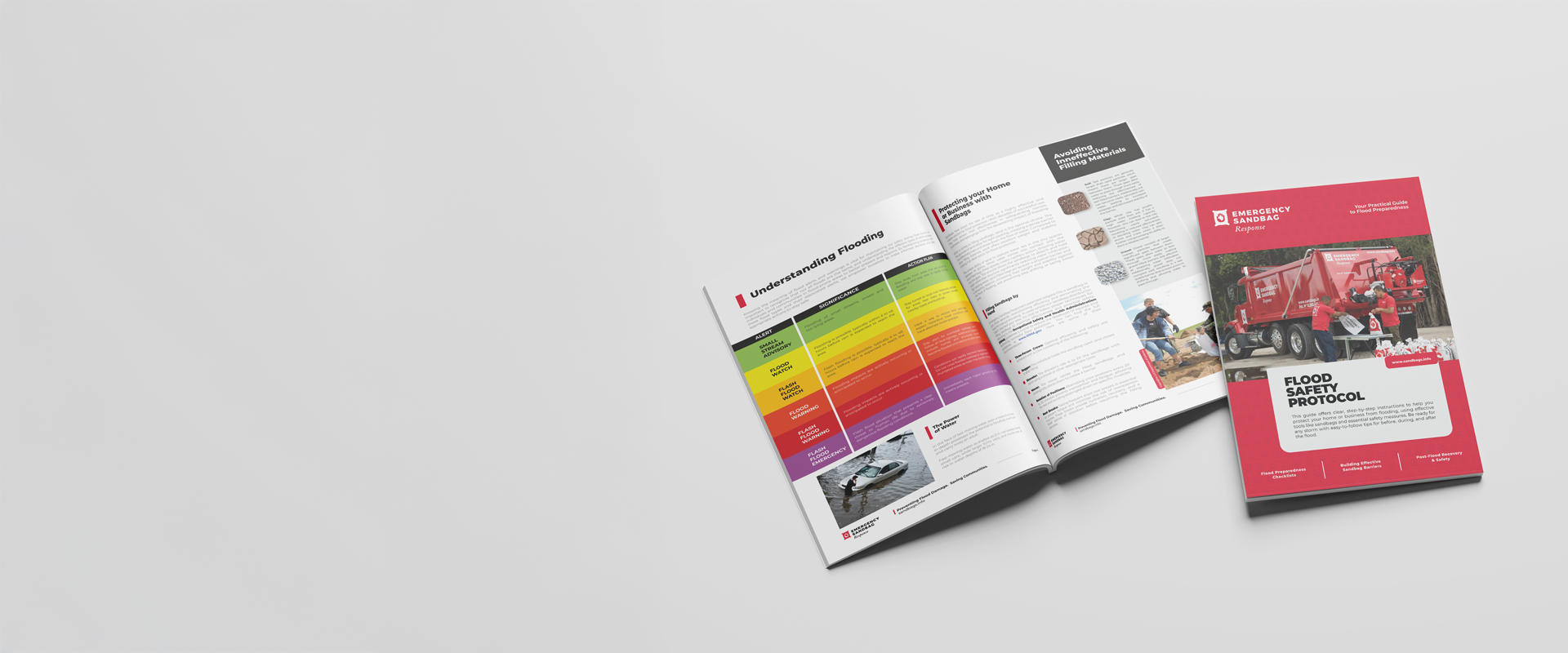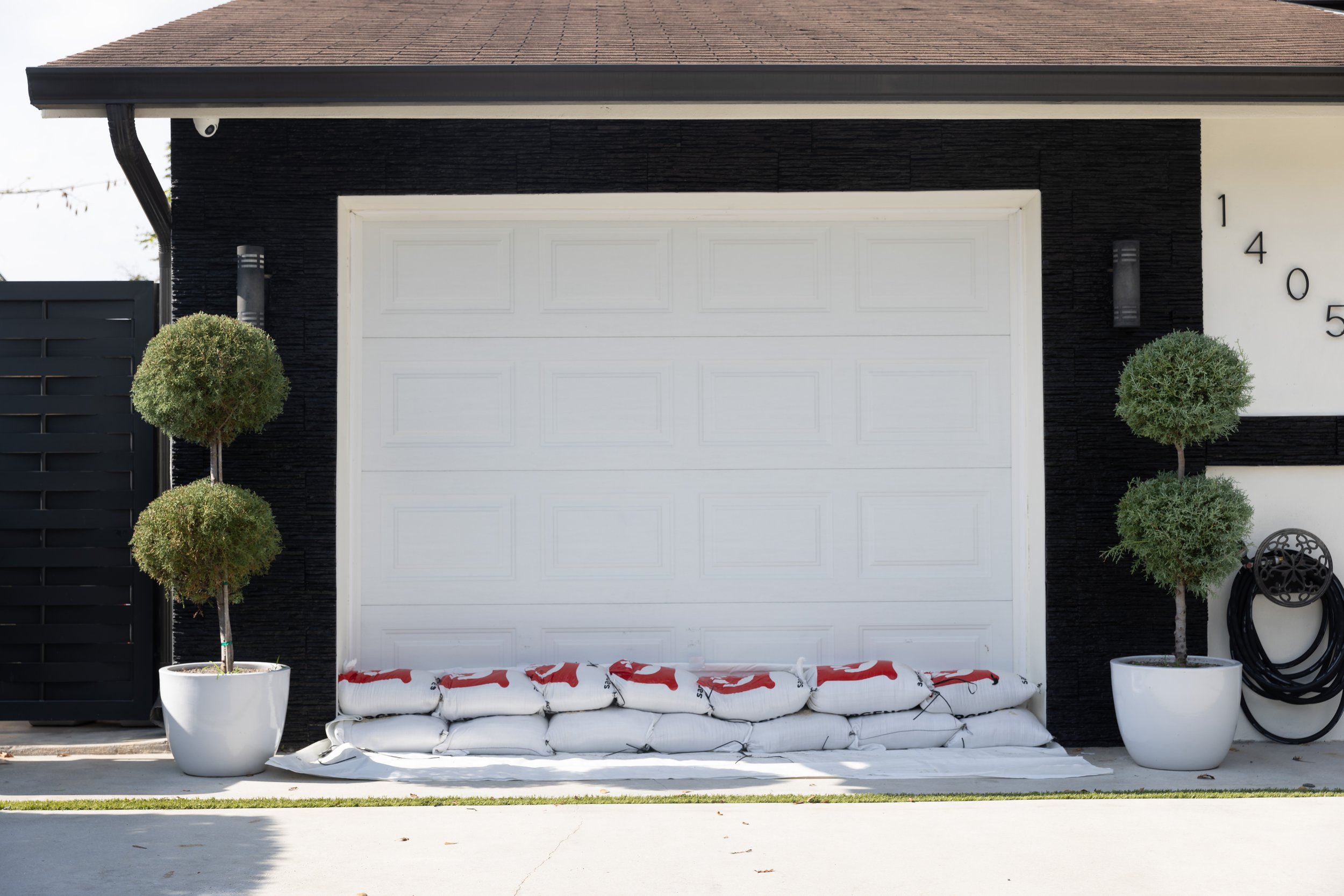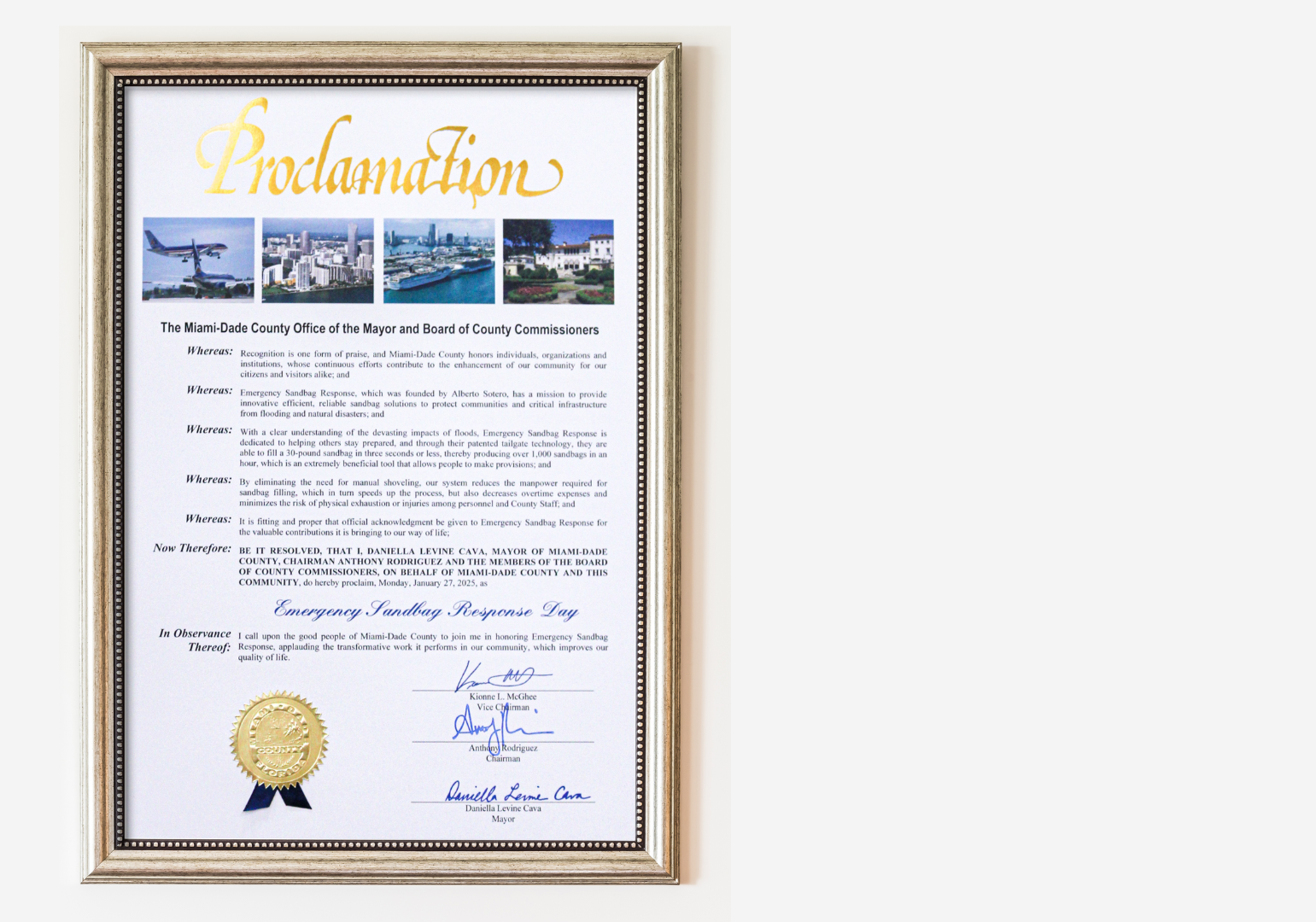ESR’s Patented Technology Revolutionizes Sandbag Filling and Distribution
Natural Disasters Strike Fast. Minimize Flood Damage with Our Custom Sandbag-Filling System, Designed for Federal, State & Local Governments.
Why Leaders Trust ESR
ESR-Ready Cities & Counties
Official Recognition from Miami-Dade County
We were honored to be formally recognized by the Miami-Dade County Office of the Mayor and Board of County Commissioners for our work in enhancing regional flood preparedness.
The proclamation highlights ESR's dedication to community safety, quoting our:
"...commitment to improving the quality of life for all residents..."
This official recognition declared January 23, 2025, as "Emergency Sandbag Response Day" in Miami-Dade County.

The ESR Advantage: A Superior Solution
Traditional Methods
Traditional sandbag distribution depends on a limited supply of government-provided sandbags. This shortage means that properties cannot be sufficiently protected from water damage, giving the community a misleading sense of security and false hope.
The ESR Way
ESR's patented system can fill a sandbag in 3 seconds. It requires no shoveling, leaves little mess, and is scalable to respond to multiple locations at once. Our team operates the system efficiently, quickly providing as many sandbags as needed.
Emergency Sandbag Response’s SMART Solution!
State of the Art Tools & Technology
Mobilize Fast & Minimize Costs
Ample Supply to Weather Any Storm
Rapid Distribution of Sandbag Resources
Treat Mitigation Without the Mess & Labor
Designed with Municipalities in Mind
Traditional sandbag distribution is slow and inefficient. It wastes time, labor, and resources, putting communities at risk. ESR eliminates the chaos with rapid, on-demand sandbag deployment. No shovels. No mess. Just instant protection when it matters most.
Time-Saving
ESR activates within hours of an emergency declaration, allowing municipal teams to respond without delays.
Cost-Effective
ESR lowers costs by eliminating the need for extra labor, equipment purchases, maintenance, and storage fees.
Safety First
Removing manual sandbagging reduces exhaustion, injuries, and liability risks for municipal staff and volunteers.
Community Flood Protection Impact
See the impact our rapid deployment capabilities can have for your community.
Homes Protected
Residential properties protected from flood damage
Potential Damages Prevented
Based on FEMA's estimate of $25k damage per inch of floodwater
Rapid Deployment
Sandbags deployed per hour
How to Obtain ESR’s Sandbags
A single truck from Emergency Sandbag Response can carry up to 1,600 pounds of sand, ready for distribution. Our team will operate the truck, ensuring seamless delivery. There are no hidden costs – sand, labor, and bags are all included. Additionally, we have pallets of sandbags ready for immediate use. ESR’s sandbags are available through various methods:
Government Distribution
ESR has partnered with numerous municipalities across the country to help provide a safe and efficient sandbag distribution process to prepare for potential floods. Contact your municipality to confirm if our ESR system is available to you. If not available, contact your government officials and let them know you want Emergency Sandbag Response as your sandbag distributor.
If you represent a municipality, contact us to help your community stay ahead and be flood-ready.
Private Distribution
Emergency Sandbag Response empowers businesses, HOAs, and neighborhoods with top-tier private sandbag distribution solutions.
Opt for our high-speed truck for on-site filling and rapid deployment, or receive pre-filled sandbags on pallets, delivered directly to your location. Our efficient and reliable services prepare you to handle potential water damage with ease.
Reach out to our team today to discover how Emergency Sandbag Response can protect your property and community.
Determining Your Sandbag Needs
ESR’s Sandbag Calculator
Use our new calculator to easily estimate how many sandbags you’ll need. Just enter your details, and get an instant recommendation to help protect your property from flooding.

Empowering Communities for Flood Preparedness
How to Protect your Property with Sandbags
Before a storm hits, it is crucial to take proactive measures to protect your home from potential flooding. One essential step is to conduct a thorough assessment of your property, carefully noting every possible entryway that may be susceptible to water intrusion. This includes doors, low windows, vents, and any other vulnerable openings. Once you have identified all the vulnerable entryways, place sandbags strategically to seal off each one. Make sure you have at least one accessible entrance and exit point for fast evacuation if needed. The proper stacking of sandbags around these entryways will increase the chances of minimizing water damage. Some of the most common entryways are as follows:
Most Commonly Asked Questions
-
Our patented Sandbag system helps us fill your bags with ease, quickly, and with almost no effort.
• Sandbags only need to be filled up to 2/3 capacity.
• If overfilled, sandbags will be too heavy to carry and will not properly divert water away.
• Only tie the top of the bag for transport purposes, as we will see later, leaving the top untied, will help build a better structure.
-
Before starting, clear debris from the area where you want to build the barrier. Don't build on uneven ground as sandbags need to settle flat.
• Place a plastic tarp in front of any doors that are threatened by flood waters. This liner is essential because sandbags alone will not stop flood water. The tarp needs to be placed high enough to cover the expected flood waters. The tarp can be attached to the doorframe with screws or stronghold tape.
• Place the first row of sandbags horizontally across the entire doorway touching the exterior of the house. Place the sandbags lengthways/parallel to the direction of the water flow.
• Start at one end and work to the other end.
• Ensure the unfilled part of the bag is covered by the next bag.
• Flatten down each row of bags by stepping on them to seal them tightly into place to eliminate gaps. Avoid any cracks that might affect the structure of the wall.
• Tuck the flap under the bag at the end of the row to prevent water from coming in through that end.
• When stacking the second and third rows, stagger the bags on top of the previous bag, offset by half the length on top of the previous bag. This method is similar to the process of laying bricks.
• For barriers over three rows high, build the wall in a pyramid shape. The base of the pyramid should be three times wider than it is tall with the bags overlapping at the seams.
-
You should place sandbags in each and every potential entryway where water is expected to flow during flooding. This includes, but is not limited to doors, low windows, and vents. Make sure that you have at least one doorway that you can use to access or exit the building - do this by building a wall in a semi-circle that allows the door to still be opened (refer to photos above).
-
(refer to photos above)
• Cover all drainage holes and floor drains to stop backflow of contaminated water
• To avoid back flow of grey water block toilets with a small plastic bag of sand, weighed down by a larger sandbag
-
• Valuables should be raised off the floor to avoid damage from floodwater that may still enter
• Make sure to lift curtains, rugs, dog beds, or other furniture that can easily absorb water, as well as remove objects from low cupboards
-
Yes, you can download our Flood Protocol Guide to learn about better practices for satefy before, during and after flooding events.

Beyond Sandbags: Smarter Flood Preparedness Starts Here.
Our system helps governments stretch budgets, reach more people faster. Get a Free Flood Preparedness consultation and learn how we can save your community time and money during floods.
Recognized by Leading News Outlets
ESR’s rapid flood response has been highlighted by national and local news for its impact in protecting communities.
FAQs for Municipalities
-
Emergency Sandbag Response is designed to be highly responsive, understanding that when it comes to natural disasters like flooding, time is of the essence. We have optimized our logistics and operations to ensure that we can deploy our advanced sandbag filling and distribution systems within just 12-24 hours following a deployment request by a municipality. This rapid response time includes the mobilization of our specialized equipment and trained personnel, as well as initial coordination with local authorities.
-
When you engage with Emergency Sandbag Response, you're not just opting for a flood mitigation service; you're securing a full-scale, end-to-end solution designed to lighten your operational load. From the storage of essential equipment to its transportation, from the efficient filling of sandbags to their distribution, and finally to the post-event cleanup, we've got it all covered.
Trained Personnel: Our team is professionally trained in the operation and maintenance of our patented sandbag filling and distribution system. When you partner with Emergency Sandbag Response, there's no need to allocate time or resources for staff training. Our experts are ready to hit the ground running, ensuring a smooth and efficient operation from start to finish.
Optimal Use of City Manpower: By entrusting the sandbag-filling operation to our trained team, city officials can reallocate their manpower to more critical emergency management tasks. This eliminates the need for sandbag-filling by city/county employees, reducing the risk of work-related injuries.
Storage: One of the advantages of partnering with Emergency Sandbag Response is that we take full responsibility for the storage of all machinery, sand, and equipment. You don't need to allocate any space or resources for storage; we've got it all taken care of. Our storage solutions are secure and ensure that all materials are kept in optimal conditions, ready for rapid deployment whenever needed.
Transportation: We are responsible for the timely and safe transport of all machinery, equipment, and sand to the designated site.
Filling and Dispensing: Our patented technology takes care of filling each sandbag on-site within 3 seconds. The system is designed for high-speed, efficient operations, capable of covering multiple locations simultaneously.
Clean-Up: Once the event has passed and the immediate threat has been mitigated, our team will handle all cleanup activities. This includes the removal of any unused sandbags, equipment, and other operational waste, leaving the site clean and orderly.
Continuous Support: Throughout the entire process, Emergency Sandbag Response provides dedicated support to address any concerns, adjustments, or emergencies that might arise.
-
While we handle the heavy lifting of flood mitigation, your role is simplified and designed for maximum efficiency, allowing you to focus on coordinating community efforts.
Staff/Volunteer Team: You would need to mobilize a team of staff members/volunteers to assist with general site operations. This could include handing off the sandbags to residents, traffic management, public guidance, and additional manual support if needed. The role of these staff members/volunteers is primarily to facilitate smooth interaction between the community and our technology.
Site Supervisor: In addition, we recommend designating one person from your team as the Site Supervisor. This individual would liaise directly with our on-site team leader to ensure that all activities are coordinated seamlessly. Their responsibility would include oversight of city/county staff and/or volunteers.
-
Emergency Sandbag Response operates nationwide, focusing on high-risk flood areas. Our rapid deployment capabilities allow us to be on-site within 12-24 hours of receiving a call, making us a reliable partner for cities and municipalities throughout the state. We are continuously evaluating the possibility of expanding our services to other regions as well, to provide our comprehensive flood mitigation solutions to as many communities as possible.
-
To get started with Emergency Sandbag Response, you have multiple convenient options to reach out to us:
- Email us at actnow@sandbags.info, and one of our representatives will get back to you promptly to discuss your specific needs.
- Call us at 888-777-0002 to speak directly with an expert who can guide you through the initial assessment and planning stages.
- Fill out the contact form provided on this website, and we'll make sure to get in touch with you as soon as possible.
Once we've established initial contact, we'll walk you through our comprehensive flood mitigation solutions and tailor a plan that best suits your community's needs. We're committed to making the process as straightforward and efficient as possible.
FAQs for Residents
-
Currently, Emergency Sandbag Response primarily focuses on large-scale sandbag distribution during floods in partnership with local governments. This allows us to efficiently deploy sandbags to areas experiencing widespread flooding. While we can't directly fulfill individual requests, we can help you prepare! Download our FREE Flood Preparedness Guide for valuable tips on protecting your property and staying safe during floods.
-
As we primarily collaborate with local governments to coordinate large-scale sandbag distribution efforts, you can be crucial in preparing your neighborhood for floods. We recommend contacting your local government officials and requesting Emergency Sandbag Response as your preferred sandbag distribution provider by visiting this link. This will help your community have the resources it needs during a flood event.
-
Since we work directly with local governments, the best way to request Emergency Sandbag Response in your area is to contact your local government officials. You can express your interest in having us as your preferred sandbag distribution provider. This collective effort helps us prepare communities for floods more effectively.





































